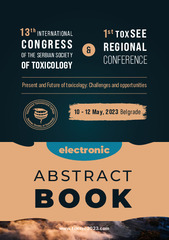Prikaz osnovnih podataka o dokumentu
Detection of double-strand breaks in DNA molecules by the γH2AX assay and analysis of the cell cycle after treatment with potential antitumor agents TBQ and its alkylthio and arylthio derivatives.
| dc.creator | Đorđević Aleksić, Jelena | |
| dc.creator | Kolarević, Stoimir | |
| dc.creator | Jovanović Marić, Jovana | |
| dc.creator | Novaković, Irena | |
| dc.creator | Žegura, Bojana | |
| dc.creator | Vuković-Gačić, Branka | |
| dc.date.accessioned | 2023-10-25T11:17:19Z | |
| dc.date.available | 2023-10-25T11:17:19Z | |
| dc.date.issued | 2023 | |
| dc.identifier.uri | http://rimsi.imsi.bg.ac.rs/handle/123456789/2174 | |
| dc.description.abstract | 2-tert-butyl-1,4-benzoquinone (TBQ) and its alkylthio and arylthio derivatives: 2-tert-butyl-5-(isopropylthio)-1,4-ben- zoquinone, 2-tert-butyl-5-(propylthio)-1,4-benzoquinone, 2-tert-butyl-5,6-(ethylenedithio)-1,4-benzoquinone, 2-tert-butyl-5-(phenylthio)-1,4-benzoquinone and 2-tert-butyl-6-(phenylthio)-1,4-benzoquinone were synthe- sized as analogs of biologically active compounds of natural origin with antitumor activity: quinone avarol/avarone. The γH2AX test was used to detect the potential genotoxic effect of TBQ and its derivatives in the HepG2 cell line. In addition, the effect of these substances on the cell cycle was monitored on the same HepG2 model system. Since the phosphorylation of histone H2AX is an early event in the cellular response to DNA double-strand breaks (DSBs), an assay based on the detection of phosphorylated histone H2AX (γH2AX) can be used as a biomarker of genotoxicity and genomic instability. In this work, the γH2AX test and flow cytometry were used to analyze the genotoxic potential and the effect on the cell cycle of TBQ and its derivatives. Double-strand breaks (DSBs) in DNA are detected with γH2AX-specific antibodies, and the cell cycle in the HepG2 cell line is analyzed by flow cytometry. Based on the obtained results, only 2-tert-butyl-5,6- (ethylenedithio)-1,4-benzoquinone induced increased formation of DSBs. Also, the same derivative caused a significantly greater arrest of cells in the G2/M phase of the cell cycle compared to TBQ from about 27% (TBQ) to 34% of the total population with a decrease in the S phase cell population. By forming DSBs, 2-tert-butyl-5,6-(ethylenedithio)-1,4-benzoquinone leads to genomic instability of the HepG2 cell line, which results in cell cycle arrest in the G2/M phase. | sr |
| dc.language.iso | en | sr |
| dc.publisher | Serbian Society of Toxicology | sr |
| dc.rights | openAccess | sr |
| dc.source | International Congress of the Serbian Society of Toxicology & 1. TOXSEE Regional Conference, Belgrade, Serbia | sr |
| dc.subject | TBQ | sr |
| dc.subject | γH2AX assay | sr |
| dc.subject | DSBs | sr |
| dc.subject | cell cycle | sr |
| dc.title | Detection of double-strand breaks in DNA molecules by the γH2AX assay and analysis of the cell cycle after treatment with potential antitumor agents TBQ and its alkylthio and arylthio derivatives. | sr |
| dc.type | conferenceObject | sr |
| dc.rights.license | ARR | sr |
| dc.rights.holder | Serbian Society of Toxicology | sr |
| dc.citation.epage | 138 | |
| dc.citation.spage | 137 | |
| dc.identifier.fulltext | http://rimsi.imsi.bg.ac.rs/bitstream/id/5783/bitstream_5783.pdf | |
| dc.identifier.rcub | https://hdl.handle.net/21.15107/rcub_rimsi_2174 | |
| dc.type.version | publishedVersion | sr |

